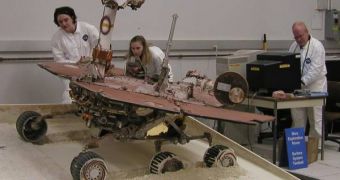According to officials at the Jet Propulsion Laboratory (JPL), in Pasadena, California, the Martian rovers' twin test brother is finally located in its sandbox at the laboratory, ready to begin its investigations into how to extract Spirit from its sandy trap. Since May 6th, the most battered rover of the MER mission to the Red Planet has been stuck in a patch of loose soil on the Martian surface, which was named Troy by the team working to unstuck the robot. After weeks of preparing the correct mixture of dirt, sand, and clay, so as to perfectly recreate Troy, the actual tests are finally about to begin.
A lot of people are now putting their faith in the JPL team, because they are the only thing standing between Spirit being stuck in sand, and the rover remaining there until it finally succumbs to the harsh conditions on Mars. The rescue operation is very difficult, because mission planners cannot really send “drive” commands to the MER component. Its condition is so fragile, that any false wheel movements could make it slip further down in the ground. At this point, it's stuck up to its hubcaps in the sand, but things could get a lot worse, JPL experts say.
They've been conducting the Spirit and Opportunity mission for the past five years, despite the fact that the robots were originally designed to last only three months in the rough conditions they were exposed to. They surprised everyone when, despite all odds, and being damaged fairly extensively, they continued to endure, and did so over the course of five winters, when temperatures were pretty low. But, despite what they want, they need to take the task currently at hand very slow, and resolve the situation step-by-step.
At this point, the test rover, which is similar to Spirit and Opportunity in every way imaginable, is located in the correct mix of sand, angled at a 12-degree inclination, just the way Troy is set up on Mars. With this template, JPL engineers will try a number of maneuvers for releasing the rover, reverting back to the initial setting every time they fail what they are doing. In the end, through trial-and-error, they hope to achieve the most effective and safe way of unjamming Spirit.
“The test facility is now configured, and the rover is in place. The first time we turn the wheels should be today,” the lead scientist for the Mars Exploration Rover Project, Steve Squyres, said in an email to Space. The simulation, however, depends on the way the test rover's wheels will spin the first time they are turned on. If they don't behave like Spirit's, then engineers will know something is wrong with the soil mixture, and will get back to working on it.

 14 DAY TRIAL //
14 DAY TRIAL //